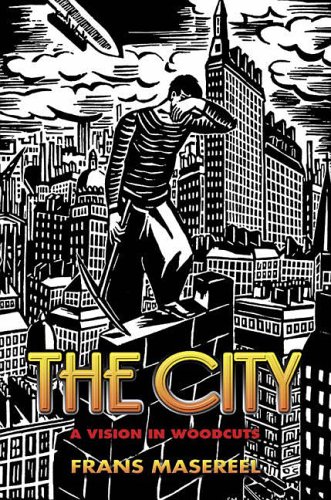
By Frans Masereel (Dover Publications)
ISBN: 978-0-486-44731-5 (TPB/Digital Edition)
We tend to think of graphic novels as being a late 20th century phenomenon, and one that fought long and hard for legitimacy and a sense of worth, but the format was pioneered popularised much earlier in the century… and utilised for the most solemn, serious and worthy purposes.
At the same time as the earliest newspaper strips were being rebound as collected editions, European Fine Artists were addressing the world’s problems in “Wordless Novels”: assembling individual artworks – usually lino or sometimes woodcuts – into narrative sequences which, as the name implies, used images, not dialogue or captions, to tell a story. This also accounts for the other names of the articles – Woodcut Novels/Novels in Woodcut.
The fashion grew out of the German Expressionist movement of the early 20th century which revived and repurposed medieval woodblock printing techniques and even imagery for its own artistic agenda and purposes and was most popular during the 1920s and 1930s. The undisputed master of the form was Flemish artisan Frans Masereel, whose many works were phenomenally popular in German and whose influence spread far and wide – particularly to Depression-era America where Lynd Ward adopted the process for his many sallies against social iniquity, and Giacomo Patri unleashed his anti-capitalist salvo in the wordless novel White Collar as well as comedic parodies such as Milt Gross’ He Done Her Wrong…
Masereel (1899-1972) was born in Blankenberge, Belgium and raised by his stepfather, an avowed socialist. He left home to study art in Paris supporting himself through magazine and newspaper illustration, political cartooning and his earliest woodcut prints. He was also a devout pacifist, refusing to fight in WWI, where he instead acted as a translator for the Red Cross. As a result he was unable to return to his homeland and lived most of his life in Germany, Switzerland and France.
In 1918 he created his first narrative: 25 Images of a Man’s Passion and followed up a year later with his masterpiece Passionate Journey. Masereel crafted more than 40 wordless novels, primarily woodcuts, but also a quartet of traditional pen & brush sagas, plus countless illustrations, commissioned paintings, animation works and more. Always stridently and forcefully defending the ordinary man from the horrors of capitalism, disaster and especially warmongering, his potent ability to hone meaning and capture emotion in singular images influenced generations of artists and cartoonists including Ward, Georg Grosz, Will Eisner, Art Spiegelman, Clifford Harper, Eric Drooker, Otto Nückel, Peter Kuper, George Walker and Peter Arno.
The book under review today was first released in 1925 as La Ville: cent bois gravés in France and as Die Stadt in Germany. Originally comprising 100 prints (13cm x 8cm) bound into book form, it quickly became a touchstone for many artists and critics and was hailed as the precursor of a film genre which made environment the focus of narrative (like Berlin: Symphony of a Metropolis or Man With a Movie Camera) and subsequently rereleased in 1961, 1972 and 1988 before this definitive 21st century Dover edition.
The City: A Vision in Woodcuts is translated from the German version as produced by Kurt Wolff Verlag AG (Munich 1925): seeking to forego actual sequential narrative by delivering its stark and startling images encapsulating the modern urban existence. Of course, humans being what we are, readers will find themselves unconsciously imposing form on those unfolding, uncompromising extremely explicit images anyway…
The candid exploration encompasses the highest and lowest echelons of society all rubbing up against each other, zeroing in page by page on the emotions, reactions and consequent horrors such friction creates…
There are bawdy entertainments, diligent toil, crimes of all kinds, quiet times almost unnoticed. We see smoke stacks, railway lines, canals, ports, traffic jams, subways and stations. There are rush hour crowds, fights, civil protests and always personal tragedies: accidents, bad births, thefts, affray, rape murder…
Buildings go up and come down, there is rush and rubbish and courtroom drama: vast office regiments, factory lines and foundry creations. Opulence and desperate poverty co-exist, with the exploited, maimed, forgotten and unwanted ignored by those enjoying themselves at all costs. The masses sing, dance, imbibe carouse and even indulge themselves being part of a grand State funeral. Always people come and people go, some for a different life and others to a “better world”…
It’s a place of constant change and the pace never slows… education, celebration and pauses for thought embrace art edification and human degradation on demand but there is also – for the bold and unbroken – a glimmer of hope…
Stirring, evocative and still movingly inspirational as the world returns to those dark days of Haves, Have-Nots and Why-Should-I-Cares?; this magnificent rediscovery is inventive, ferocious in its dramatic delivery, instantly engaging and enraging: a book long overdue for revival and reassessment and one every callous “I’m All Right” Jackass and “Why Should I Pay For Your…” social misanthrope needs to see or be slapped with…
No © asserted.
